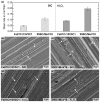A Newly Designed High-Strength Tool Steel with High Wear and Corrosion Resistance
- PMID: 36903058
- PMCID: PMC10003919
- DOI: 10.3390/ma16051941
A Newly Designed High-Strength Tool Steel with High Wear and Corrosion Resistance
Abstract
In this study, a newly developed high-strength cast Fe81Cr15V3C1 (wt%) steel with a high resistance against dry abrasion and chloride-induced pitting corrosion is presented. The alloy was synthesized through a special casting process that yielded high solidification rates. The resulting fine, multiphase microstructure is composed of martensite, retained austenite and a network of complex carbides. This led to a very high compressive strength (>3800 MPa) and tensile strength (>1200 MPa) in the as-cast state. Furthermore, a significantly higher abrasive wear resistance in comparison to the conventional X90CrMoV18 tool steel was determined for the novel alloy under very harsh wear conditions (SiC, α-Al2O3). Regarding the tooling application, corrosion tests were conducted in a 3.5 wt.% NaCl solution. Potentiodynamic polarization curves demonstrated a similar behavior during the long-term testing of Fe81Cr15V3C1 and the X90CrMoV18 reference tool steel, though both steels revealed a different nature of corrosion degradation. The novel steel is less susceptible to local degradation, especially pitting, due to the formation of several phases that led to the development of a less dangerous form of destruction: galvanic corrosion. In conclusion, this novel cast steel offers a cost- and resource-efficient alternative to conventionally wrought cold-work steels, which are usually required for high-performance tools under highly abrasive as well as corrosive conditions.
Keywords: abrasive wear behavior; as-cast microstructure; corrosion; mechanical properties; microstructural characterization; multiphase tool steels.
Conflict of interest statement
The authors declare no conflict of interest.
Figures









References
-
- Davis J.R. ASM Specialty Handbook: Tool Materials. ASM International; Almere, The Netherlands: 1995.
-
- Berns H., Theisen W. Eisenwerkstoffe—Stahl und Gusseisen. Springer; Berlin/Heidelberg, Germany: 2008. - DOI
-
- Mesquita R.A. Tool Steels: Properties and Performance. CRC Press; Boca Raton, FL, USA: 2016.
-
- Huth S., Krasokha N., Theisen W. Development of wear and corrosion resistant cold-work tool steels produced by diffusion alloying. Wear. 2009;267:449–457. doi: 10.1016/j.wear.2008.12.089. - DOI
-
- Mc Collum J.M., Serrano Delgado I. Opportunities for Fluoropolymers—Synthesis, Characterization, Processing, Simulation and Recycling. Elsevier; Amsterdam, The Netherlands: 2020. Manufacturing strategies in fluorinated polymers and composites.
Grants and funding
LinkOut - more resources
Full Text Sources
Miscellaneous

